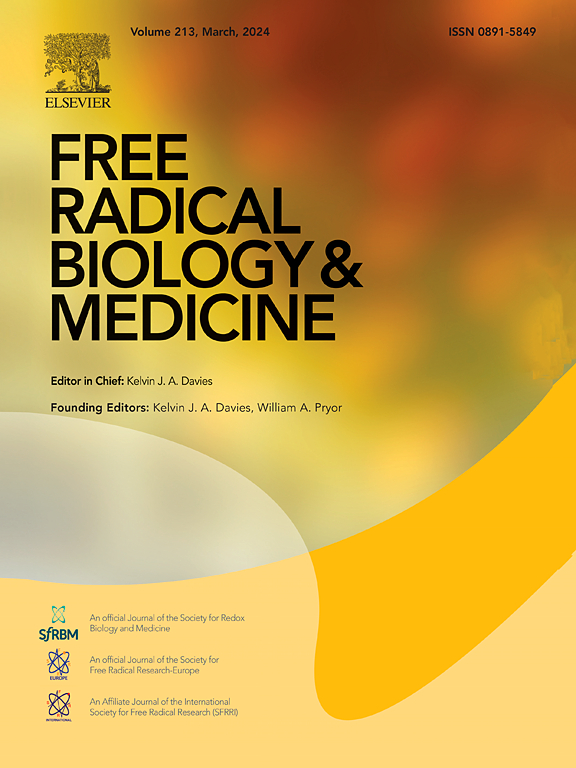超声响应的牛磺酸脂纳米颗粒减轻氧化应激并促进巨噬细胞极化促进糖尿病伤口愈合。
IF 7.1
2区 生物学
Q1 BIOCHEMISTRY & MOLECULAR BIOLOGY
引用次数: 0
摘要
由于神经免疫相互作用的破坏,糖尿病伤口愈合提出了一个重大的临床挑战。本研究发现α7烟碱乙酰胆碱受体(α7nAChR)通过将胆碱能信号通路与巨噬细胞重编程联系起来,是伤口修复的关键调节因子。对糖尿病足溃疡(DFU)微环境的GEO分析显示,神经元丢失、M1巨噬细胞优势和慢性炎症均由乙酰胆碱(ACh)分泌受损和α7nAChR失活驱动。在机制上,牛磺酸(TA)通过激活AMPK,减轻氧化和内质网应激,促进乙酰胆碱生成,恢复高糖条件下PC12细胞的功能。ACh激活巨噬细胞α7nAChR,通过JAK2/STAT3激活和NF-κB抑制调节M1/M2极化。为了提高TA的生物利用度,研究人员开发了超声响应的Ccr2靶向TA纳米颗粒(Ccr2@TA@LNP),通过Ccl2/Ccr2趋化性进行位点特异性递送。在糖尿病神经病变(DPN)小鼠中,Ccr2@TA@LNP通过增加ACh水平、增强α7nAChR/CD206表达和减少ccl2介导的炎症来加速伤口愈合。通过整合神经保护、巨噬细胞重编程和靶向纳米治疗,本研究强调了TA作为一种多靶点药物,通过AMPK/α7nAChR/JAK2-STAT3轴恢复神经免疫平衡,为糖尿病伤口治疗提供了一种新的治疗策略。本文章由计算机程序翻译,如有差异,请以英文原文为准。

Ultrasound-responsive taurine lipid nanoparticles attenuate oxidative stress and promote macrophage polarization for diabetic wound healing
Diabetic wound healing presents a significant clinical challenge due to disrupted neuro-immune interactions. This study identifies the α7 nicotinic acetylcholine receptor (α7nAChR) as a key regulator of wound repair by linking cholinergic signaling to macrophage reprogramming. GEO analysis of diabetic foot ulcer (DFU) microenvironments revealed neuronal loss, M1 macrophage dominance, and chronic inflammation, all driven by impaired acetylcholine (ACh) secretion and α7nAChR inactivation. Mechanistically, taurine (TA) restored PC12 cell function under high glucose conditions by activating AMPK, alleviating oxidative and endoplasmic reticulum stress, and promoting ACh production. ACh activated macrophage α7nAChR, modulating M1/M2 polarization through JAK2/STAT3 activation and NF-κB suppression. To enhance TA bioavailability, ultrasound-responsive Ccr2-targeted TA nanoparticles (Ccr2@TA@LNP) were developed for site-specific delivery via Ccl2/Ccr2 chemotaxis. In diabetic neuropathy (DPN) mice, Ccr2@TA@LNP accelerated wound healing by increasing ACh levels, enhancing α7nAChR/CD206 expression, and reducing Ccl2-mediated inflammation. By integrating neuroprotection, macrophage reprogramming, and targeted nanotherapy, this study highlights TA as a multi-target agent that restores neuro-immune balance through the AMPK/α7nAChR/JAK2-STAT3 axis, offering a novel therapeutic strategy for diabetic wound treatment.
求助全文
通过发布文献求助,成功后即可免费获取论文全文。
去求助
来源期刊

Free Radical Biology and Medicine
医学-内分泌学与代谢
CiteScore
14.00
自引率
4.10%
发文量
850
审稿时长
22 days
期刊介绍:
Free Radical Biology and Medicine is a leading journal in the field of redox biology, which is the study of the role of reactive oxygen species (ROS) and other oxidizing agents in biological systems. The journal serves as a premier forum for publishing innovative and groundbreaking research that explores the redox biology of health and disease, covering a wide range of topics and disciplines. Free Radical Biology and Medicine also commissions Special Issues that highlight recent advances in both basic and clinical research, with a particular emphasis on the mechanisms underlying altered metabolism and redox signaling. These Special Issues aim to provide a focused platform for the latest research in the field, fostering collaboration and knowledge exchange among researchers and clinicians.
 求助内容:
求助内容: 应助结果提醒方式:
应助结果提醒方式:


